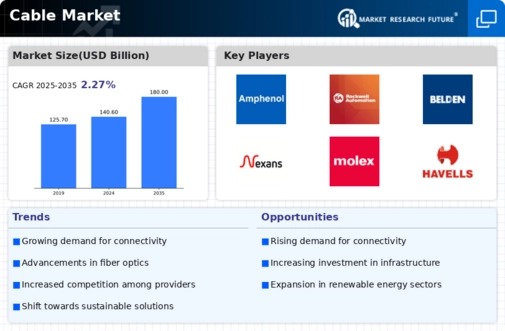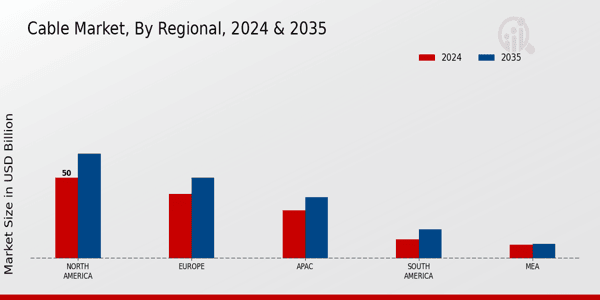Market Growth Projections
The Global Cable Market Industry is poised for substantial growth, with projections indicating a market value of 140.6 USD Billion in 2024 and an anticipated increase to 180 USD Billion by 2035. This growth trajectory reflects a compound annual growth rate of 2.27% from 2025 to 2035, highlighting the sustained demand for cable solutions across various sectors. Factors such as infrastructure development, technological advancements, and regulatory support are likely to drive this expansion. The market's resilience in adapting to changing consumer needs and technological innovations suggests a promising outlook for stakeholders in the Global Cable Market Industry.
Rising Demand for Renewable Energy
The Global Cable Market Industry is experiencing a notable surge in demand due to the increasing focus on renewable energy sources. As countries strive to meet their sustainability goals, the need for efficient transmission of electricity generated from wind, solar, and hydroelectric sources becomes paramount. This shift is expected to drive the market value to approximately 140.6 USD Billion in 2024, with projections indicating a growth trajectory towards 180 USD Billion by 2035. The integration of advanced cable technologies is crucial for enhancing the efficiency and reliability of energy distribution, thereby supporting the overall growth of the Global Cable Market Industry.
Infrastructure Development Initiatives
Infrastructure development initiatives across various regions are significantly influencing the Global Cable Market Industry. Governments are investing heavily in upgrading and expanding their electrical grids to accommodate growing urban populations and industrial demands. This trend is particularly evident in emerging economies, where rapid urbanization necessitates robust infrastructure. The anticipated growth in market value to 180 USD Billion by 2035 reflects the critical role of cable systems in supporting these developments. Furthermore, the implementation of smart grid technologies is likely to enhance the efficiency of power distribution, thereby further propelling the Global Cable Market Industry.
Regulatory Support for Cable Standards
Regulatory support for cable standards is playing a pivotal role in shaping the Global Cable Market Industry. Governments and international bodies are establishing stringent standards to ensure safety, efficiency, and environmental sustainability in cable production and usage. This regulatory framework not only promotes innovation but also encourages manufacturers to adopt best practices in cable design and installation. As a result, the market is expected to benefit from increased consumer confidence and demand for compliant products. The emphasis on regulatory compliance is likely to contribute to the projected growth of the Global Cable Market Industry, reinforcing its importance in various sectors.
Increased Investment in Telecommunications
The Global Cable Market Industry is witnessing increased investment in telecommunications infrastructure, driven by the growing demand for high-speed internet and data services. As digital connectivity becomes essential for both individuals and businesses, the need for robust cable networks is more pronounced. This trend is particularly evident in regions with expanding urban centers, where the demand for reliable internet services is surging. The anticipated growth in market value to 140.6 USD Billion in 2024 underscores the importance of telecommunications in shaping the future of the Global Cable Market Industry. Enhanced cable systems are vital for supporting the increasing data traffic and connectivity needs.
Technological Advancements in Cable Manufacturing
Technological advancements in cable manufacturing are reshaping the Global Cable Market Industry. Innovations such as the development of high-performance materials and improved manufacturing processes are enabling the production of cables that are not only more efficient but also more durable. These advancements are crucial for meeting the increasing demands of various sectors, including telecommunications and energy. As a result, the market is projected to grow at a CAGR of 2.27% from 2025 to 2035, indicating a sustained interest in enhancing cable performance. The ongoing research and development efforts in this area are likely to further bolster the Global Cable Market Industry.



















